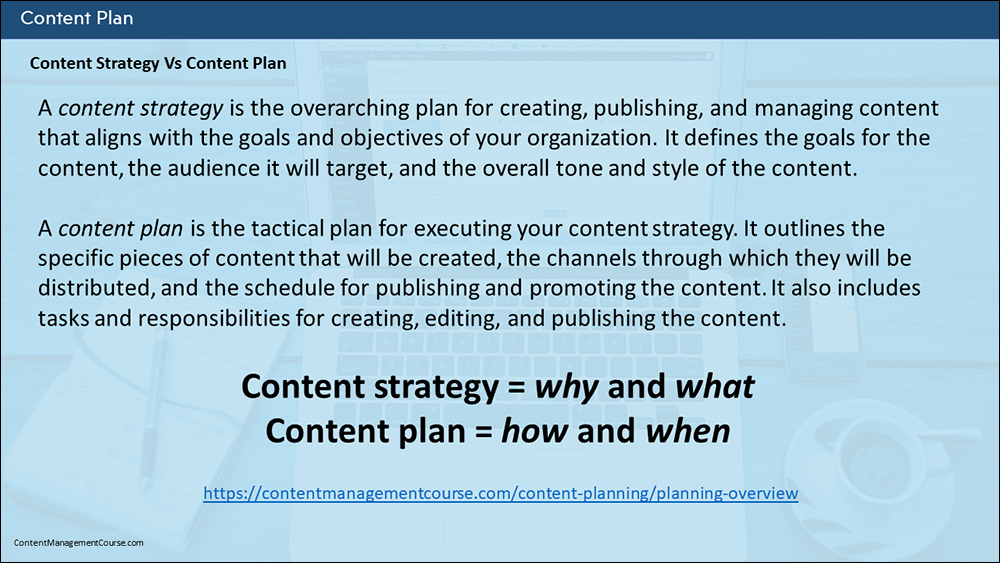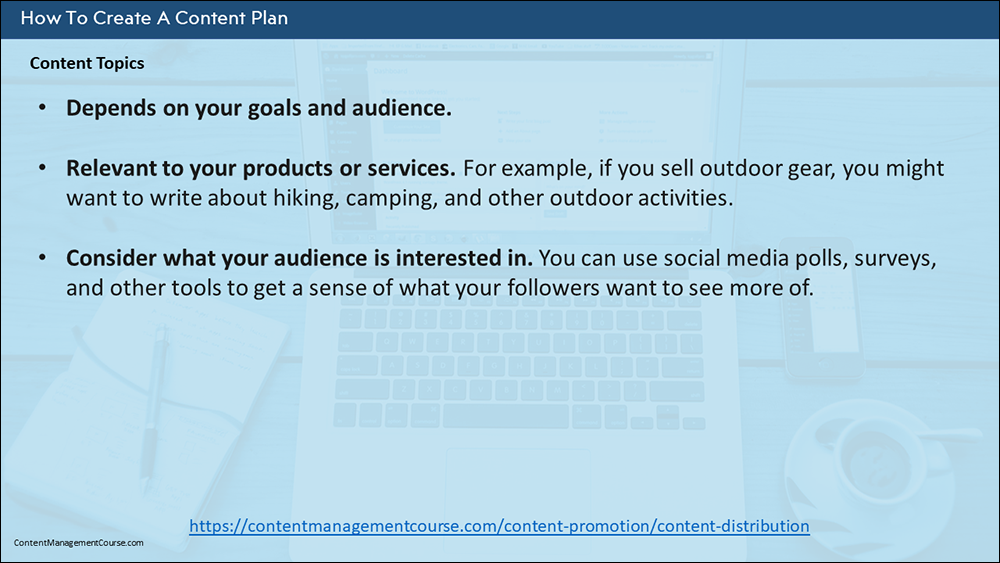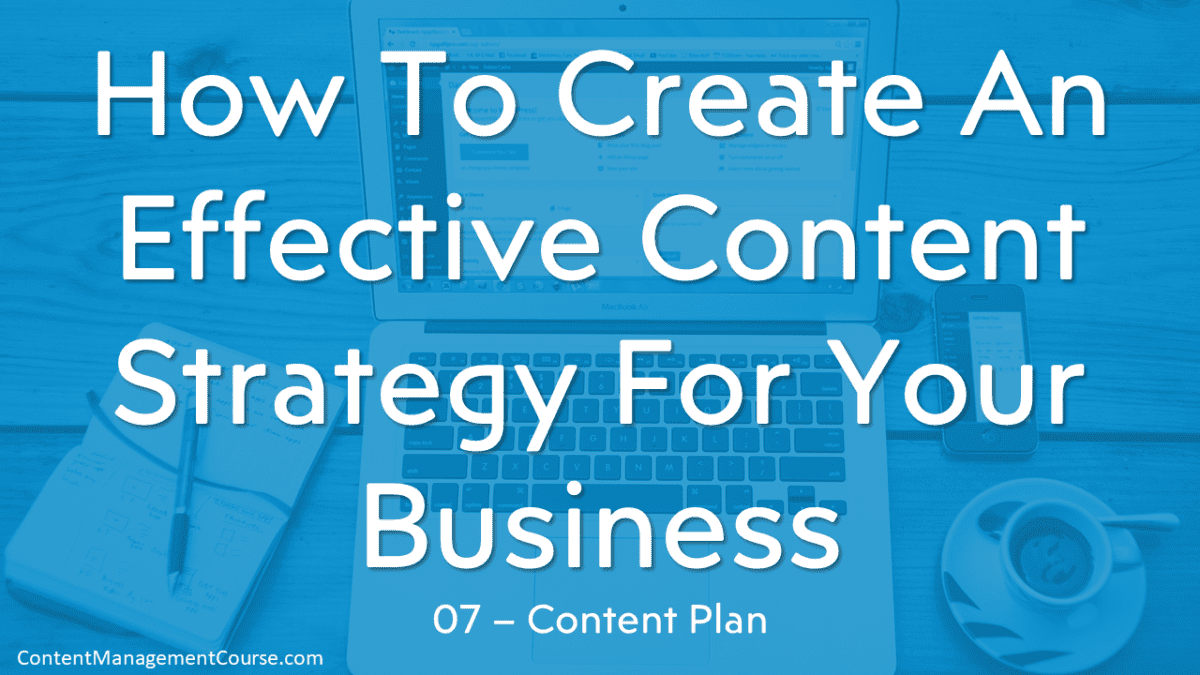How To Create An Effective Content Strategy For Your Business – Part 7: Content Plan
Learn how to create an effective content strategy for your business with this free video course. Part 7 of 12.
 This is Part 7 of our free How To Create An Effective Content Strategy For Your Business video course.
This is Part 7 of our free How To Create An Effective Content Strategy For Your Business video course.
This lesson covers creating a content plan – what a content plan is, why your business needs one, and how to create a content plan for your business.
***
Watch the video lesson below or refer to the video transcript:
Video Transcript

Welcome back to our video course on how to create an effective content strategy for your business.
This is module 7.

In the previous lesson, we looked at doing a content audit, which is taking an inventory of all of our existing content.
In this lesson, we’ll look at how to create a content plan so we can start implementing our content strategy in our business.

So, this is where we take all of the information we’ve been compiling about our audience, setting content goals, choosing content types, and doing a content audit, and we put it all together into a cohesive and actionable plan.

In this lesson, we are going to cover what a content plan is, why your business needs one, and how to create a content plan that will deliver your business results.

So, what is a content plan?

A content plan is a document that specifies what content your business will create to target your audience at all stages of their buyer journey, and how this content will be created, distributed, and managed.
A content plan also outlines…
- who is responsible for creating the content,
- what the purpose of the content is, and
- how the content impacts your content strategy

The difference between a content plan and a content strategy, is that a content strategy is the overarching plan for creating, publishing, and managing content that aligns with the goals and objectives of your organization.
A content strategy defines the goals for the content, the audience it will target, and the overall tone and style of the content.
A content plan, on the other hand, is the tactical plan for executing your content strategy.
A content plan outlines the specific pieces of content that will be created, the channels through which they will be distributed, and the schedule for publishing and promoting your content. It also includes tasks and responsibilities for creating, editing, and publishing your content.
So, in short, a content strategy tells us the why and what, and a content plan tells us the how and when.

Now, why does your business need a content plan?

Your business needs a content plan to ensure that the right systems and workflow processes are put in place to create the right content, for the right audience, at the right time, using the right distribution channels, to help your business achieve its strategic goals.
So essentially, the goal of the content plan is to deliver the goals of the content strategy.

Now that we have a basic understanding of what a content plan is and why our business needs one, let’s look at how to create a content plan.

Here I’ve outlined 12 steps to creating a content plan and I’m just going to touch on these briefly in this lesson because I’ve written a comprehensive tutorial that covers all of these steps in detail and you can go through each of these at your own pace by visiting the link on the screen.

So in Step 1, we ask the question “what do we want our content to achieve?” Are we looking to increase brand awareness, generate leads, or drive sales? We covered this step in module 4 of this course.
We also covered Step 3 which content types to focus on in module 5, so if you need help in those areas, just go back and review those modules.

So let’s take a brief look, then, at Steps 2, 4, and 5, which is setting the frequency, topics, and distribution of our content.
And these are the questions that we need to ask
- How often should we be publishing new content?” This will tell us the frequency.
- What content should we be writing or talking about?” This will tell us the topics to write about, and
- How should we be getting our content out into the world?” This will tell us the distribution methods.

So let’s look at frequency first.
It’s important to find a sustainable balance between producing enough content to keep your audience engaged, but not so much that it becomes overwhelming or low quality.
It also depends on the type of business you’re in. For example, if you run a news website, you’ll probably need to publish multiple articles a day to keep up with the latest developments. On the other hand, if you’re running a personal blog or a small business, you might only have the capacity to publish once or twice a week or a few times a month.
So, it’s important to consider our audience, our resources, and our goals when determining the frequency of our content. In general, it’s a good idea to find a frequency that we can sustain over the long term. Consistency is key when it comes to content marketing, so it’s better to publish on a regular schedule rather than trying to push out as much content as possible and then burn out.

Next up, are the topics you should be writing or talking about. Again, this will depend on your goals and audience.
If you’re running a business, you’ll want to focus on topics that are relevant to your products or services. For example, if you sell outdoor gear, you might want to write about hiking, camping, and other outdoor activities.
It’s also a good idea to consider what your audience is interested in. You can use social media polls, surveys, and other tools to get a sense of what your followers want to see more of.

Finally, there’s distribution. There are many options to choose from when it comes to getting your content out, including social media, email newsletters, press releases, guest blogging on other websites, and so on.
So it’s important to find the right mix of distribution channels for your business or personal brand. For example, if you’re targeting a younger audience, you might want to focus on social media platforms like Instagram and TikTok. And if you’re targeting a more professional audience, you may want to target channels like LinkedIn.
Another important area of distribution is understanding that there are different types of distribution channels, like owned media, paid media, and earned media.
Owned media is content that you create, own, and have full and complete control over. Like blog posts and articles that you write and publish on your website.
Paid media is where you pay to promote your content. Like taking ads on Google and social media.
And then there’s earned media, which is content that someone else creates, and you don’t pay for it but it benefits your business. Like when someone posts a great review about your business.
You can read more about these distribution channels by visiting the link on the screen.

Our content plan needs to align with our content strategy, so if our content strategy includes paid media, this brings up the next step, which is how to allocate our resources.
So the two main areas we need to focus on here are financial and personnel resources.

Financial resources mostly come down to the budget allocated to create and distribute content and to invest in the right tools.
So, if our content strategy specifies using paid media to distribute our content and there’s no budget for paid media, we’re going to have a problem.
We either have to try and find the budget, or rework our content strategy and content plan to focus more on owned media like blog posts and articles.
Which brings up the issue of personnel resources.

So, what kind of content team can your business afford to put together?
Creating and promoting content involves many different skills and responsibilities.
Whatever talent you have available to create and promote content is going to have a tremendous impact on your content plan.
For example, I run a number of websites on my own and I also work with a team in my full-time job, and both of these have pros and cons.

Working with a content team, for example, requires having really effective communication.
So, to implement a content plan effectively with a team means that we need to establish a central point of contact. This can be a content manager or a designated member of the team.
We also need to set up regular meetings or check-ins with all relevant teams and stakeholders and establish clear guidelines and processes for creating and approving content.
We’ll cover some parts of this step in this lesson, like setting up a content calendar. But in the next lesson, we’ll talk about editorial guidelines and workflow processes for reviewing and approving content.

It’s also very important to choose the right tools to ensure that everyone has access to the latest version of the content plan.
So, this would be like a document management system and also setting up team communication channels so everyone can communicate effectively, especially if your team comprises of people working remotely.
This can be done using tools like Slack and email, plus tools for live meetings, conference calls, and online presentations, like Zoom, Google Meet, Microsoft Teams, Skype, etc.
And we also need to choose our content management tools. These include Project Management Software like for example, Monday.com, or Asana, Jira, or Trello, and a Content Management System like WordPress, Drupal, or Joomla.
Once again, the tools you choose will depend on your budget, your needs, and how you’ve designed your workflow processes.
If you need more information about these tools, visit the links on the screen.

After choosing the tools your team will use to collaborate, communicate, and manage your content, the next step is to set up a content publishing schedule to organize and schedule your content creation and promotion activities.
Typically, this will be a tool that lets you set up and manage a content calendar or an editorial calendar.
Now, these terms are often used interchangeably, but an editorial calendar generally outlines each step of the process, while a content calendar usually covers one aspect, such as when posts are published or shared to social media.
If you’re just starting out, you can use a spreadsheet to track your content publishing schedule, but if keeping track of things starts to become too hard, you might want to use a calendar tool.
Some project management tools and content management systems also include scheduling features, so whichever method you choose, just make sure that everyone in your team can access the tool and that they know how to use it.
For a detailed tutorial on how to set up a content scheduling calendar, visit the link shown on the screen.

Now, we’re almost done setting up our content plan.
We just need to work out how to assign tasks and set deadlines for everyone who is involved in creating and promoting our content.
And here are some things to keep in mind.
First, we want to provide clear and detailed descriptions of the task and ensure that everyone on the team understands the expected outcomes.
So include any necessary resources or instructions.
Also, we want to take each team member’s skills and workload into consideration and make sure that we assign the task to the right person.
It’s also important to set realistic deadlines by learning to estimate accurately how long tasks will take to complete and how complex they are.
We also want to clearly communicate tasks and deadlines to assigned team members.
To do this, we can use team meetings, email, or a project management tool to follow up with team members and make sure they understand the task and have what they need to complete it.
And we also want to check in with our team members periodically to keep track of their progress, offer assistance and support, provide additional resources, and answer any questions they may have.
Finally, it’s important to create guidelines for assigning tasks to members that include all the points we’ve just discussed and add these guidelines to your workflow documentation.

The next step in creating your content plan is to include ways to measure content performance and content ROI, so you can see which parts of the plan are working and which areas will need improvement.
With content performance, we want to set up metrics to measure and analyze our content’s performance in areas like engagement, traffic, lead generation, conversions, bounce rates, and so.
We also want to set up ways to track revenue generated from our content and compare this to the costs of creating and promoting our content to work out our return on investment.
The links on the slide will take you to tutorials on how to set up content metrics, content tracking and a content measurement plan, and lists of tools you can use to measure your content performance.

Now the last step in creating our content plan is to schedule a periodic review of the plan itself to make sure that everything set out in the plan is progressing along, that all strategic goals are being met, and to figure out how to improve things if the goals are not being met.

So, in summary, a content plan tells us how and when to execute our content strategy.
Follow the steps we’ve covered in this lesson to create and implement a content plan for your business, and if you need help in any of these areas refer to the tutorials listed on the screen.

So, that’s all for this lesson.
In the next lesson, we’ll look at how to break our content plan into a content production plan, a content promotion plan, and a content management plan, so we can create, promote and manage our content more effectively.
Thank you for watching and I’ll see you in the next lesson.
- Go to Lesson 8.
- Return to the video course outline.
Tutorials
See the following lessons and tutorials for more information about the topics covered in this video lesson:
***
Image: Robin Higgins. Music Bensound.
